Chip in Now to Stand Up for Working People
Working people need a voice more than ever and Working America is making that happen.
Working people need a voice more than ever and Working America is making that happen.

10/29/2022
Anyone who watches television, uses the internet or owns a cell phone in a battleground state can attest to how overwhelming the political ads are right now (see the chart from Wesleyan Media Project below). The focus of advertising is a good indication of what the parties want the election to be about in voters’ minds. Although it varies by state, two issues are near the top of the heap in both ads and earned media — abortion rights for Democrats and inflation for Republicans.
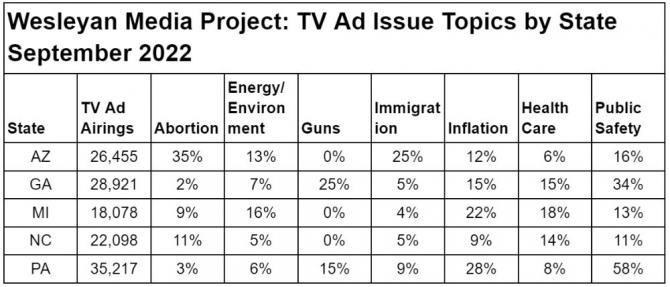
But how much is either issue influencing races?
We know that the issues voters focus on predict which candidates they end up supporting, often despite the voter’s partisan leanings. In those 10,000 face-to-face canvass conversations we’re conducting every day, we have taken note of what those issues are in battleground races — and they are not always what the candidates’ campaigns want them to be.
For example, in the Pennsylvania Senate race, 58% of ads in September were about public safety (the theme is that Black people in Philadelphia are scary). Yet, in more than 21,000 conversations with voters in the greater Philadelphia region in September, public safety was only the fifth-most important issue for all voters, and an even lower priority for Republicans.
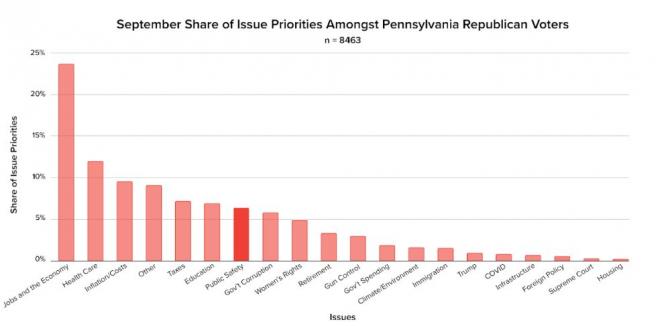
Voters are complex and don’t always give their attention to the issue campaigns expect. In some cases, the news cycle or other outside events can shift voters’ attention, and that attention shapes the outcome in elections.
Take Georgia, for example. Looking at the basket of Democratic-leaning issues most frequently cited by voters — abortion, health care and education— we see that since Labor Day, the focus on health care (the blue band) has dipped, along with the fuller basket of Democratic issues. The saving grace has been abortion rights as a top issue driven by the early October surge in attention. The reason seems obvious: controversial revelations about GOP Senate candidate Herschel Walker’s efforts to get a woman he was in a relationship with to get an abortion.
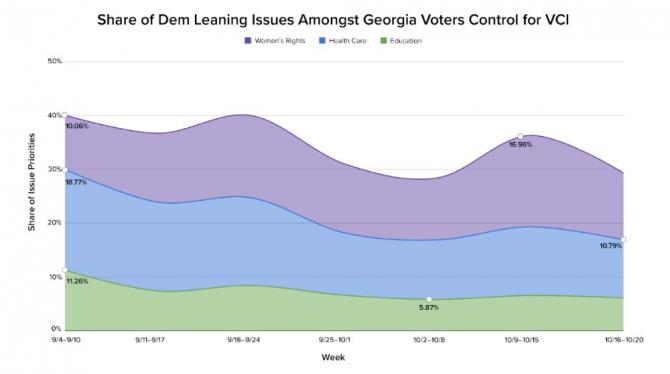
Voter concerns about abortion rights in Georgia have been far higher all cycle than the 2020-21 runoff elections, when only 1.5% of voters we canvassed mentioned the issue. But it has not played big in the communications plans for campaign ads (only 2% of the total spending in September).
Abortion rights are generally a more favorable issue for Democrats than even an issue like health care. In the Georgia Senate race, about 86%of voters we canvassed who identified health care as their top priority planned to vote for Democrat Raphael Warnock, while voters focused on abortion rights chose Warnock about 91% of the time.
But when abortion rights do come up in our conversations, the results can still be unexpected.
For example, we spoke to Jennifer Ann, a 47-year-old white female voter from Smyrna, Georgia, whose top issue was health care. When we started the conversation, she was voting for Republican incumbent Brian Kemp for governor and was undecided for the Senate race. After the canvasser compared the candidates’ records on health care, she said, “Herschel Walker is a joke” who doesn’t understand what the office is about and she believed Walker “doesn’t respect women and their reproductive rights.” She is now voting for Warnock — but told us that she still backs Kemp over Abrams. Remember that in 2019, Kemp signed a state law banning abortion after the 6th week of pregnancy. What voters make of the information they hear does not always follow a straight line of reasoning.
When we look at the polling averages, we see that this uptick in focus on abortion rights tracks the widening of Warnock’s margin over Walker, but as the fuller basket of Democratic-leaning issues declines, the race tightened.
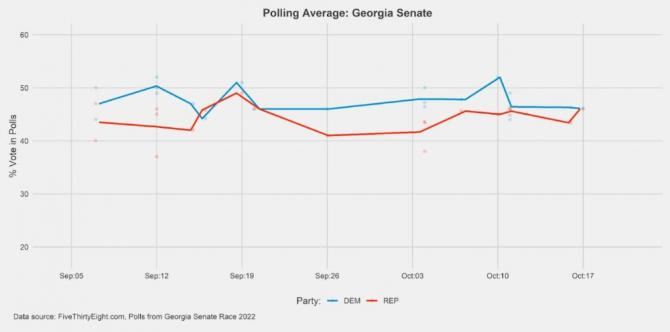
But we can also look at where the shift toward inflation advantages the Republicans. From shortly after Michigan’s primary election in August, the salience of the top GOP-leaning issues — inflation and the economy — increased by more than 10 points among our canvass sample. At the same time, Democrat Gretchen Whitmer’s lead over the GOP’s Tudor Dixon narrowed.
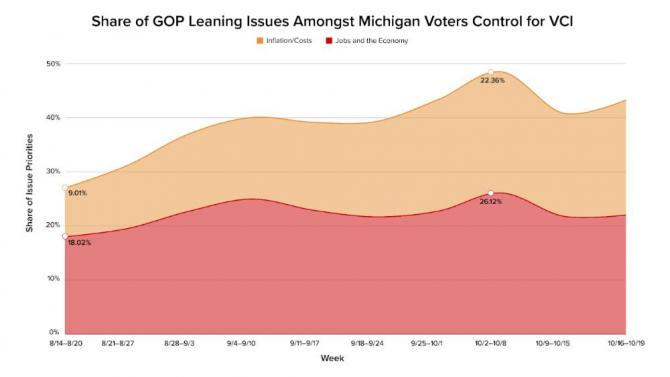
In September, 22% of television campaign ads were about inflation. That month and through the second week of October, focus on inflation surged to become the top concern of nearly a quarter of our sample. At the same time, Whitmer’s Labor Day lead of 11 points in the polling averages further narrowed to 8.5 points by Oct. 17th.
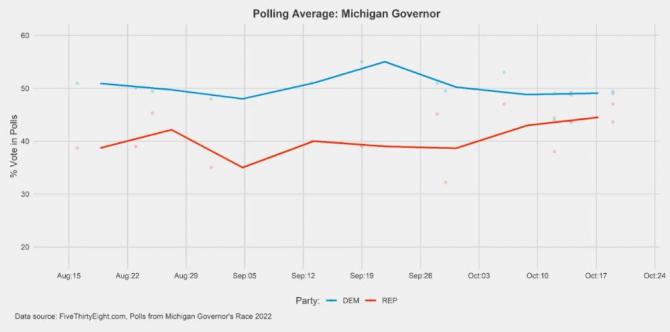
These relationships between issue focus and vote choice are not 1-to-1, but are often correlated. [See more issue trends in other battleground states here .]
The broader trend is what we are up against. When we look at the gubernatorial and Senate contests across Arizona, Georgia, Michigan and Pennsylvania collectively, it’s clear that the political climate has shifted in favor of Republican candidates, in correlation with the set of issues that voters care most about (although that issue momentum is showing some signs of leveling off).
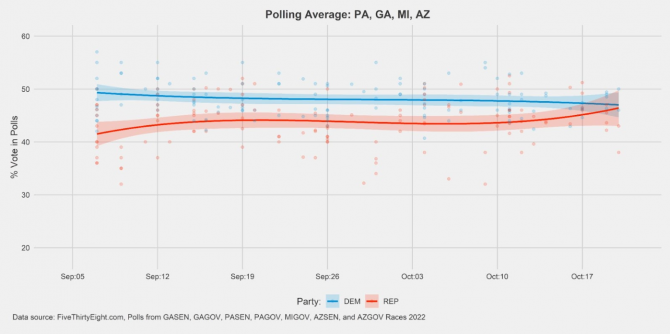
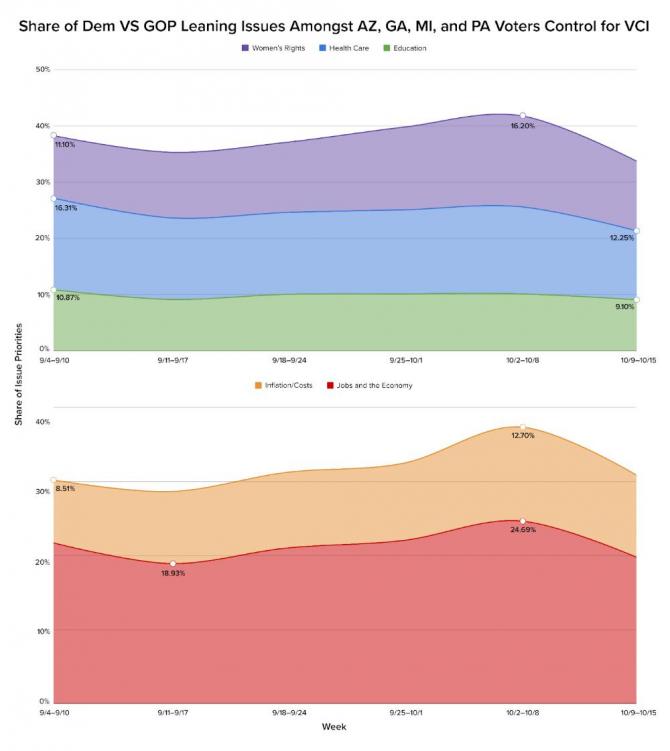
But as the examples above show, massive spending on television ads is not always a reliable way to influence the issue landscape. So what are our other options? As you likely guessed, our answer is to connect with voters on a personal level, share with them our common experiences and concerns, and invite them to join us in action. Our canvass and digital organizers do it every day at a nearly industrial scale, measurably influencing partisan and issue concerns. But we also have a legion of dedicated activists who use another of the most old-fashioned of strategies — sharing a personal experience about their own concerns with a working-class voter in the form of a letter.
“Until recently, I’d always been healthy and never cared about health insurance. Then, I got an eye infection and suddenly needed frequent care from a specialist. I was unprepared for the thousands of dollars in extra costs, and I now have to pay every year for the rest of my life for a chronic, pre-existing condition. It made me realize that nobody is safe from bad luck, and that reliable, affordable health care is essential for everyone.” — Su C., Cambridge, MA
These messages, straightforward and heartfelt, aren’t about candidates, campaigns, politicians or elections. They are about people talking about human experiences. And, true to form, our randomized control trials show that they are not only really effective at getting people to care about affordable health care, but they are also one of the most effective tools a volunteer can use to influence elections. (If you want to learn about how you can participate and more on the science behind the letters, you can check it out here.)
The political answer is yes and no. (This is just a discussion of what our campaign messages should be, not about which issues are actually most critical for action.) Democrats and their allies focusing attention and communications resources on abortion rights makes sense, as it has one of, if not the biggest, partisan advantages among issue priorities. But in most places, that is already being done (or in some cases not done, presumably for smart reasons).
But when we look at which voters are slipping away from Democrats in past weeks, it turns out that those voters simply care less about abortion rights and more about inflation and costs. (They also happen to be more male than those focused on abortion rights.) We may also already be approaching a natural ceiling of people who vote on abortion rights (for example, the 10X increase in abortion-rights voters in Georgia since 2020).
Looking across our battleground states, it is clear that we need to defang GOP messages about inflation and the economy with facts that align with our candidates, such as the danger of unchecked prescription drug price increases and the centrality of increasing worker pay in improving the economy. We will dive more into exactly that in future updates.
As always, thank you for your support. See you on the doors.
Matt
We use cookies and other tracking technologies on our website. Examples of uses are to enable to improve your browsing experience on our website and show you content that is relevant to you.